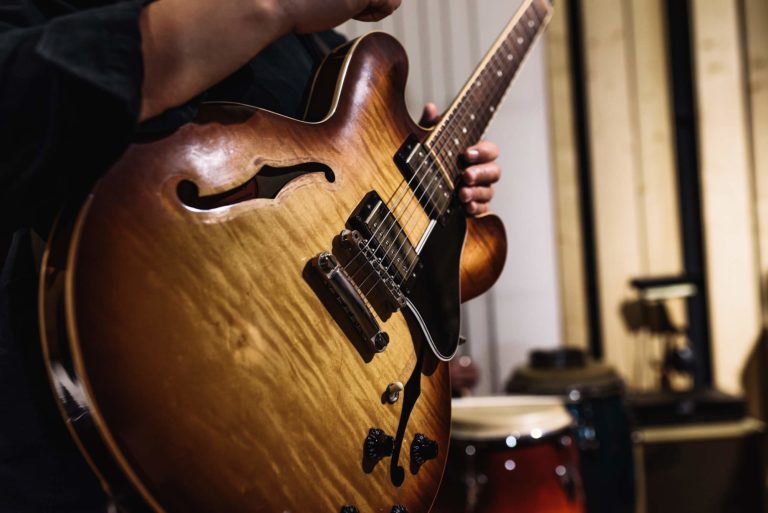Guitar River is reader-supported. We may earn a commission when you make a purchase using the links on our site.
Learn more.
What Electric Guitars Are Made Of And Why It Matters

If you spend any time in the guitar community, you will undoubtedly hear discussions about tonewoods and how they affect the guitar’s sound. This is an age-old topic, and we will probably be discussing it long into the future.
Guitars are constructed primarily out of wood. The materials used in the construction of the guitar do have an impact on the guitar’s tone. This will be most apparent with acoustic guitars that rely on the characteristics of the wood for their sound.
Electric guitars have other components such as the pickups and the bridge that impact the guitar’s tone. But the variety of tonewood used in an electric guitar does make a difference. The debate concerns the degree and type of tonal difference between the varieties of wood.
In this post, we will take a brief look at the properties of the wood, as well as what other materials factor into the guitar’s sound.
Wood Type and Composition
When looking at guitar specs, you will notice a variety of tonewoods used in the guitar construction. Guitar bodies, necks, and fretboards are constructed from basswood, maple, rosewood, pau ferro, ebony, mahogany, swamp ash, and other lesser-known woods.
Of course the type of wood refers to the tree species. You might also see some variation in the country of origin. For example, rosewood may be sourced from Brazil, India, or Honduras. Note, there are recent restrictions on the trade of rosewood that we will review below.
Wood varies in density, weight, hardness, and moisture content. The climate in which the tree grows influences the composition of the wood. Environmental conditions including light, temperature, wind, and available moisture have an impact on tree growth.
Taking swamp ash as an example, the trees are partially submerged for a portion of the year. The root systems extend into wet ground below the waterline. With these conditions, the tree will create larger gaps between the cellular walls, ultimately creating a low-density and resonant wood.
Both alder and maple trees are found in colder climates, and the wood is denser and harder. These properties contribute to a brighter sounding tonewood.
Drying Process
The wood is dried before it’s used in the construction of a guitar. This drying process determines the amount of moisture within the wood. Too much moisture can dampen the sound by absorbing vibration, and affect the tuning stability of a guitar.
The drying process varies by wood type. Drying the wood removes moisture and crystallizes resin. This produces a material that will be more consistent over time. The natural seasonal expansion and contraction is reduced by the drying process, resulting in more stability.
Check out this video tour of the PRS SE factory in Indonesia. The drying process for rosewood is demonstrated, and it’s fascinating to see the careful planning and amount of work that goes into the guitar construction.
Wood Combinations
Once dried, each wood variety has a certain sonic characteristic when used in a musical instrument. There are traditional wood combinations used by guitar manufacturers such as an alder or ash body paired with a maple neck in Telecasters and Stratocasters, or a mahogany body and neck with a rosewood fretboard in a Les Paul.
Here is a list of some popular guitars and the type of wood used for each component.
| Guitar | Body | Neck | Fretboard |
| Fender Player Stratocaster | Alder | Maple | Maple or Pau Ferro |
| Fender American Professional II Stratocaster | Alder | Maple | Maple |
| Squier Classic Vibe ‘70s Stratocaster | Poplar | Maple | Indian Laurel |
| Fender Player Telecaster | Alder | Maple | Maple |
| Fender American Professional II Telecaster | Alder | Maple | Rosewood |
| Squier Classic Vibe ‘50s Telecaster | Pine | Maple | Maple |
| Gibson Les Paul Standard ‘60s | Mahogany | Mahogany | Rosewood |
| Gibson SG Standard ‘61 | Mahogany | Mahogany | Rosewood |
| Gibson ES-335 | Maple, Poplar, Spruce | Mahogany | Rosewood |
| Gibson ES-345 | Maple, Poplar, Spruce | Mahogany | Rosewood |
| Gibson Explorer | Mahogany | Mahogany | Rosewood |
| Ibanez RG8570Z | African Mahogany | Maple, Wenge | Bound Macassar Ebony |
| Ibanez RG5121 | African Mahogany | Maple, Wenge | Bound Macassar Ebony |
| Ibanez GRG131DX | Poplar | Maple | Bound Purpleheart |
| Yamaha Pacifica | Alder | Maple | Rosewood |
| Jackson JS Series Dinky | Poplar | Maple | Amaranth |
| Jackson Pro Series Soloist SL2 | Basswood | Maple | Ebony |
As you can see from the above table, there are some popular combinations and wood choices for the body, neck, and fretboard. Why would a manufacturer choose one variety over another? The tonal profile of the wood, as well as the cost, availability, and the manufacturing process all factor into the decision.
Tonal Characteristics
The tone of the guitar is created from the sum of its parts. The tonewoods selected influence the sound, but so does the bridge, nut, pickups, and even the strings. Here are some of the most popular tonewoods and their tonal characteristics.
Alder
If you note the above chart, alder is used for the Stratocasters and Telecasters. The Yamaha Pacifica body is also made from alder. It’s a popular choice for the guitar body, and has a strong and balanced sound with emphasis on the midrange tones. Alder bodies are usually finished with an opaque finish such as a polyurethane.
Ash
Ash is also used for guitar bodies and produces a more resonant sound than alder, with a brighter top end and good sustain. Swamp ash is a sought after variant, and is becoming more difficult to find due to environmental concerns. Ash has a pleasing wood grain and is often finished with a clear finish to show off the wood grain.
Basswood
Basswood is employed as a guitar body wood, and is more affordable than some other wood varieties. However, it’s a good tonewood, and used on guitars at all price points. Sonically, basswood creates a full sound with a thick midrange. You’ll see it in use on the Jackson Soloist above.
Ebony
Ebony is used for guitar fretboards as a higher-end alternative to rosewood. It is similar to rosewood from a tonal perspective, and is viewed as a premium upgrade. It is used in combination with maple, wenge, and mahogany on the Ibanez models above.
Mahogany
Mahogany is a classic choice for both guitar necks and bodies. Note that Gibson features the wood for both components in the Les Paul and SG. Ibanez also uses it as a body wood in the higher-end RGs. Guitars built with mahogany are usually equipped with humbuckers and have a warm and rich sound with some depth.
Maple
Maple is a dense and hard wood, widely used in guitar necks and fretboards. And it is also featured as a top or veneer on some guitar bodies. Maple can be paired with a lighter wood for a composite body. The sound of maple can be described as bright and precise. One way to hear the difference is to try the same model of guitar with a rosewood fretboard and a maple fretboard.
Poplar
Poplar is an affordable choice used on less expensive import models. It’s not known for any stand-out tonal properties, and may be somewhat lacking when it comes to sustain and resonance.
Pau Ferro
Pau Ferro has recently emerged on the scene as an alternative to rosewood. It is a South American wood with tonal properties similar to rosewood. I would argue that it’s sonically somewhere in between rosewood and maple, and closer to rosewood. It has a smoother, mellower tone than maple, but not quite as warm as rosewood.
Rosewood
Rosewood is a dark, and well-regarded tonewood. It is widely used as a fingerboard wood, and can be found in acoustic guitar bodies. Some manufacturers such as Fender are also making guitars with solid rosewood necks. A less common usage for rosewood is in an electric guitar body. Rosewood has a balanced and rounder tone that works well with a maple neck.
Exotic and Less Common Woods
If you note the woods used in the Ibanez guitars above, you’ll find wenge, bound purpleheart, and amaranth used along with mahogany and maple. Manufacturers often feature less common woods for their physical appearance, unique sonic characteristics, and as an alternative to other more traditional woods.
Environmental and Ethical Concerns
Rosewood has been in the news recently. Restrictions on the use of rosewood went into effect in 2017 under CITES (Convention on International Trade in Endangered Species of Wild Fauna and Flora). Demand for rosewood–primarily for use in furniture production–led to deforestation and environmental problems in certain areas.
With the new restrictions, guitar manufacturers such as Fender sought out alternative woods to use in guitar production. You’ll notice that many darker-wood fretboards are now made out of pau ferro instead of rosewood.
Unfortunately, swamp ash is now facing a supply shortage due to climate change and an invasive beetle infestation. Swamp ash grows along the lower portion of the Mississippi River. The trees are partially submerged during the year with seasonal flooding, and harvested when the floodwaters recede.
Because of increasingly wetter seasons and the beetle infestation, swamp ash is in short supply. The future of this wood as a choice for guitar bodies looks in doubt, and manufacturers are seeking alternatives.
Weight and Playability
The varieties of wood used in guitar construction factor heavily to the overall weight of the instrument. Guitars with ash and alder bodies are going to be lighter than their mahogany counterparts.
Strat style guitars are usually lighter than LP style guitars, though not always. I have a Strat style that weighs in around 11 pounds, while my Fender Standard Strat is about 7 pounds. I played an Ibanez RG at Guitar Center recently, and it felt like a feather by comparison.
The weight will vary between types of guitars, and even within individual models of guitars. Read more in our post on what guitars weigh, and why it matters.
Bridge and Pickups
Since we are discussing electric guitars here, we need to mention the bridge and pickups. The pickups have a large part in creating the guitar’s tone. Changing a pickup can alter the sound of your guitar substantially. However, the underlying tonewoods still have an impact on the overall resonance, sustain, and tonal characteristics.
The bridge also affects the guitar’s tone. With a tremolo bridge, a larger block will increase resonance and sustain. Some players replace the stock tremolo block with a brass block to add warmth, clarity, and sustain. A solid piece of metal, whether brass or steel, is going to be better than an inexpensive alloy which is sometimes used in lower-end guitars.
Wrapping Up
To summarize, electric guitars are largely made out of wood. Some other materials such as metal and plastic are used as well. Wood is a natural material, and varies in hardness, density, and tone. Each wood type is chosen by guitar manufacturers for its unique properties, and combined with other woods to create a guitar with a certain tone.



